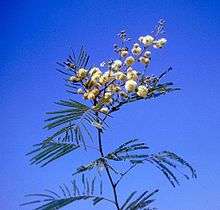Senegalia berlandieri
Senegalia berlandieri (Berlandier Acacia, Guajillo Acacia, guajillo, huajillo) is a shrub native to the Southwestern United States and northeast Mexico that belongs to the subfamily Mimosoideae (wattles) of Fabaceae (legumes). It grows 1 to 5 metres (3.3 to 16.4 ft) tall, with blossoms that are spherical and white, occurring from February through April.[1] The berlandieri epithet comes from the name of Jean-Louis Berlandier,[2] a French naturalist who studied wildlife native to Texas and Mexico. S. berlandieri contains a wide variety of alkaloids and has been known to cause toxic reactions in domestic animals such as goats.[3][4]
| Senegalia berlandieri | |
|---|---|
 | |
| Scientific classification | |
| Kingdom: | |
| (unranked): | |
| (unranked): | |
| (unranked): | |
| Order: | |
| Family: | |
| Genus: | |
| Species: | S. berlandieri |
| Binomial name | |
| Senegalia berlandieri (Benth.) Britton & Rose | |
 | |
| Range of Senegalia berlandieri | |
| Synonyms | |
|
Acacia berlandieri Benth. | |
Uses
S. berlandieri is toxic to livestock and thus should not be used as forage or fodder.[5] The honeybees use the flowers to make a honey that is as clear as water.[6] This is a very important honey-plant, or tree, rather, in Texas, for the dry arid portions where there is little or no irrigation, and where nothing, in fact, grows except mesquite, catclaw, sage-brush, and other desert plants. The fact that it does not depend on irrigation, and needs only a scanty amount of rain early in the season, makes it most valuable to the bees in those regions where it grows and yields large quantities of beautiful water clear honey. Indeed, it is the finest produced in Texas, and is so nearly water white as to be almost as clear as pure water. It is at its very best in the region of Uvalde, Texas."[7]
Alkaloids
S. berlandieri contains a number of diverse alkaloids, the most plentiful of which are N-methylphenethylamine, tyramine, and phenethylamine.[3] The total alkaloid content in dried leaves has been reported to be in the range 0.28-0.66%.[8] In a recent study, researchers identified thirty-one alkaloids in samples of plant foliage, including trace amounts of four amphetamines previously known only from laboratory synthesis: amphetamine, methamphetamine, para-hydroxyamphetamine and para-methoxyamphetamine. Other trace alkaloids include nicotine, and mescaline (found in many cacti but infrequently in other plants).[3] The same group of researchers later reported finding most of the same alkaloids in A. rigidula, a related species also native to the Southwestern U.S.[9] There are no reports in the literature of these findings having been repeated, however, leading to the suggestion that they resulted from cross-contamination or were possibly artifacts of the analytical technique.[10]
Gallery
 Senegalia berlandieri foliage and flowers
Senegalia berlandieri foliage and flowers Senegalia berlandieri tree
Senegalia berlandieri tree Senegalia berlandieri bark
Senegalia berlandieri bark Senegalia berlandieri flowers and seed pods
Senegalia berlandieri flowers and seed pods Senegalia berlandieri seeds
Senegalia berlandieri seeds
References
- University of Texas Native Plant Information Network
- Holloway, Joel Ellis (2005). A Dictionary of Common Wildflowers of Texas & the Southern Great Plains. Texas Christian University Press. ISBN 978-3-540-63293-1.
- B.A. Clement, C. M. Goff and T. D. A. Forbes (1997). "Toxic amines and alkaloids from Acacia berlandieri." Phytochemistry 46 249-254.
- I. J. Pemberton, G. R. Smith, T. D. Forbes, and C. M. Hensarling (1993). "Technical note: an improved method for extraction and quantification of toxic phenethylamines from Acacia berlandieri." J. Anim. Sci. 71 467-70. http://www.journalofanimalscience.org/content/71/2/467.full.pdf
- "Guajillo". Texas Toxic Plant Database. Texas A&M University.
- p281 of "The ABC and XYZ of Bee Culture" by A. I. Root "HUAJILLA. (Zygia brevifolia, Sargent)
- A.I. Root and E.R. Root, (1910), "The ABC and XYZ of Bee Culture" https://archive.org/stream/abcxyzofbeecultu00root#page/281/mode/2up
- Hegnauer, Robert mass (1994). Chemotaxonomie der Pflanzen. Springer Science+Business Media. p. 500. ISBN 978-3-7643-2979-2.
- B. A. Clement, C. M. Goff, and T.D. A. Forbes (1998). "Toxic amines and alkaloids from Acacia rigidula." Phytochemistry 49 1377-1380.
- "Acacias and Natural Amphetamine". Ask Dr. Shulgin Online. Center for Cognitive Liberty & Ethics. 2001-09-26.
External links
| Wikimedia Commons has media related to Acacia berlandieri. |
| Wikispecies has information related to Acacia berlandieri |
